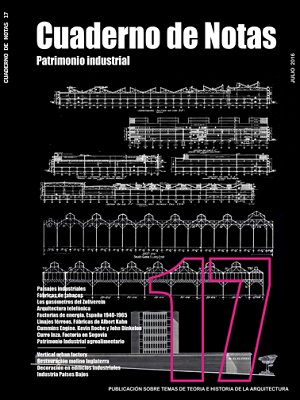Decorative Systems of Industrial Buildings: a foray into uncharted regions
DOI:
https://doi.org/10.20868/cn.2016.3489Palabras clave:
Ornament, industrial buildings, iconography, decorative, factory industrial heritageResumen
This article is a reprint of the original published in the journal Ezelsoren, Bulletin of the Institute of History of Art, Architecture and Urbanism (IHAAU) of the Delft University of Technology (TU Delft). It appeared in Volume III, Number 3, 2012 and is, as indicated in the text, a sample of how far "the very extensive number of buildings constructed since the beginning of industrialization in relation to many technical purposes, from railway stations to slaughterhouses, from power plants to coal mines, haven´t been sufficiently studied in relation to their ornamental and sculptural systems, which in turn represent the reaction of the arts to the course of technological development.” An artistic material still largely unexplored whose wealth is waiting to be unveiled as an eloquent field of interpretation of the past.Descargas
Referencias
Walt Whitman Rostow, The Stages of Economic Growth: A non-Communist Manifesto, Cambrid- ge/ USA 1960, 1990(3rd edition)
Sigfried S. Giedion, Mechanization Takes Command, a contribution to anonymous history, Oxford 1948; German edition: Die Herrschaft der Mechanisierung. Ein Beitrag zur anonymen Ges- chichte, Frankfurt a.M. 1982, 2000 (latest edition)
Francis Donald Klingender, Art and the Indus- trial Revolution, London 1947; German edition: Kunst und industrielle Revolution, Dresden 1974 (following the 1968 edition of Arthur Elton)
Francis Donald Klingender, Art and the Indus- trial Revolution, rev. and ed. by Arthur Elton, New York 1968
Cf. Lutz Engelskirchen, Eisen und Stahl. Ausste- llungen zum Industriebild in Deutschland, in: Die zweite Schöpfung, exhibition catalogue Berlin 2002, p. 108-113 (catalogue financed by the same firm of Krupp that held the 1912 exhibi- tion in Essen)
Kuratorium Kunstausstellung Eisen und Stahl (Ed.), Kunstausstellung Eisen und Stahl, exhibition catalogue Essen 1952
Paul Brandt, Schaffende Arbeit und bildende Kunst, 2 vol., Leipzig 1927/28
Klaus Türk, Bild der Arbeit. Eine ikonographische Anthologie, Wiesbaden 2000
Hanne Abildgaard and Aase Bak (Ed.): Indus- triens billeder, exhibition catalogue, Odder 2007
Josef Adolf Schmoll genannt Eisenwerth, Denkmäler der Arbeit Entwürfe und Planungen, in: Hans-Ernst Mittig, Volker Plagemann (Ed.): Denkmäler im 19. Jahrhundert. Deutung und Kritik (=Studien zur Kunst des 19. Jahrhunderts 20) München 1972, p. 253-281; 443-464; more recently two newer volumes present both a German and an American collection of sculptural works representing the world of work and industry: Türk, Klaus: Arbeiterskulpturen, vol. 1:. Figuren aus dem Grohmann Museum an der Milwaukee School of Engineering, Milwaukee 2009, Arbeiterskulpturen, vol. 2: Die Sammlung Werner Bibl., Essen 2011
Adolf Loos, Ornament und Verbrechen, Wien 2000 (reprint of the original of 1908)
For examples see: Karin Depicker and others, Enseignes, images de pierre. XVII et XVIII siecles, Alleur/Belgium 1991
Edgar Jones, Industrial Architecture in Britain 1750-1939, London 1985, p. 16f.
ibd., p. 24; in this context also very interesting: James Maud Richards, The Functional Tradition in Early Industrial Buildings, London 1958
Karl Friedrich Schinkel, Reise nach England, Schottland und Paris (ed. Gottfried Riemann), Berlin 1986, p.244
Wolfgang Schivelbusch, Geschichte der Eisen- bahnreise. Zur Industrialisierung von Raum und Zeit im 19. Jahrhundert, München/Wien 1977; English Edition: The Railroad Journey: The Industrialization of Time and Space in the Ninete- enth Century, Berkeley 1986
Karen Bowie (Ed.), Les grandes gares parisien- nes du XIX siècle, Paris 1987
Axel Föhl, Manfred Hamm, Bahnhöfe, Berlin 1984, p. 98-100. 140
Janusz Dobesz, Die Breslauer Bahnhofsarchitek- tur im 19. Jahrhundert und ihre Beziehung zur Schinkel-Schule, in: neue heimat Monatshefte 3/81, p. 74-76
Museo di Arte Moderna e Contemporanea di Trento e Rovereto(Ed.), Angiolo Mazzoni. Archi- tetto Ingegnere del Ministero delle Communica- zioni, exhibition catalogue, Milan 2003, pp.145- 154
Ann Thorson Walton, Ferdinand Boberg Archi- tect. The Complete Work, Cambridge/USA 1994, p. 118- 121
Axel Föhl, Technische Denkmale













